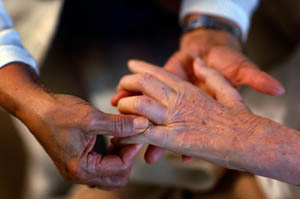Home care technology can play a critical role in keeping patients out of hospitals and at home, but many providers believe new policies should be used to encourage its adoption.
Advocates for those changes were on Capitol Hill yesterday to push for legislation that would expand the use of such technology, which allows home health agencies and nurses to remotely monitor a patient’s vital signs, like heart activity and blood pressure, and be able to flag troubling symptoms before they become medical emergencies.

Photo by Joe Raedle/Getty Images
Such technology is important as people live longer with more chronic conditions and seek to stay in their homes, the advocates told congressional staff at a presentation sponsored by Philips Healthcare, the National Association for Home Care and Hospice and the Home Care Technology Association of America. It also could be critical as Medicare prepares to penalize hospitals next year for frequently readmitting patients within 30 days for heart failure, heart attacks and pneumonia.
“We have to come up with other solutions to manage these chronic conditions outside the expensive acute care setting,” said Mark Szewczyk, the general manager of remote patient monitoring at Philips Healthcare, a company that provides diagnostic, treatment and preventive care products including many for home health. “Telehealth and remote monitoring are really going to be solutions in the future. The reimbursement and policy piece is what we’re waiting to catch up.”
Medicare and most private insurers do not reimburse for home health care technology despite its increasing use among providers. Legislation pending in Congress seeks to expand the use of telehealth under Medicare by providing incentives to home health agencies that use it in rural and underserved urban communities and can demonstrate savings. Sen. John Thune (R-S.D.) introduced the Fostering Independence Through Technology (FITT) Act last March with eight co-sponsors. The bill creates pilot programs and other implementation procedures for efforts to demonstrate health savings and performance targets. Participants at the event are pushing for its passage this year, believing it might be likely as more lawmakers seek bipartisan cost-saving solutions.
“You wouldn’t need a FITT Act if Medicare wasn’t out of sync with today’s medical needs,” said Suzanne Mintz, president and CEO of the National Family Caregivers Association. “The fact that Medicare doesn’t cover it is a sign that Medicare was designed as an acute care program for people who didn’t have many years to live.”
About 90 percent of seniors have at least one chronic condition and about 77 percent have two or more, according to Szewczyk.
Home health agencies are increasingly investing in such technology despite limited resources and the lack of reimbursement because they believe it will provide future cost savings. Telehealth sales are growing at an average of about 35-40 percent a year, Szewczyk said.
Speakers at the Hill meeting also noted the support that such systems can provide to patients and their families. “Family caregivers, despite their numbers, feel very isolated,” Mintz said. “The idea of being connected to a nurse who can react on the spot … has a very powerful effect.”






